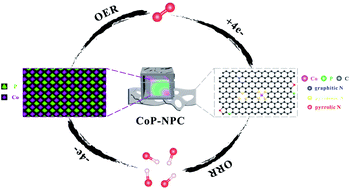Phosphorization of a Prussian blue analogue-derived Co–N–C catalyst for synchronously boosting the oxygen reduction and evolution reactions†
Abstract
The development of sustainable energy technologies and devices urgently requires reasonable construction of inexpensive and high activity bifunctional electrocatalysts. However, different active sites are required for bifunctional electrocatalysts, increasing the complexity of electrocatalyst construction. In this study, a bifunctional electrocatalyst (denoted as CoP-NPC) which consists of CoP nanocubes and Co–N–C sites embedded on the N,P co-doped carbon matrix is synthesized by a pyrolysis-phosphorization approach of the composite of the CoCo-Prussian blue analogue (CoCo-PBA), graphitic carbon nitride nanosheets (GCNS), polydopamine (PDA) and sodium hypophosphite (NaH2PO2). The phosphorization process induces the synergism of CoP, Co–N–C, and NPC, providing abundant and efficient catalytically active sites. As a result, the CoP-NPC displays significant improvement in electrocatalytic activities with a half-wave potential of 0.821 V and a low overpotential of 308 mV at 10 mA cm−2 for the ORR and OER. Moreover, the CoP-NPC material exhibits outstanding stability and tolerance to methanol. This study provides a facile phosphating strategy to simultaneously boost the catalytic activity of bifunctional electrocatalysts.



 Please wait while we load your content...
Please wait while we load your content...